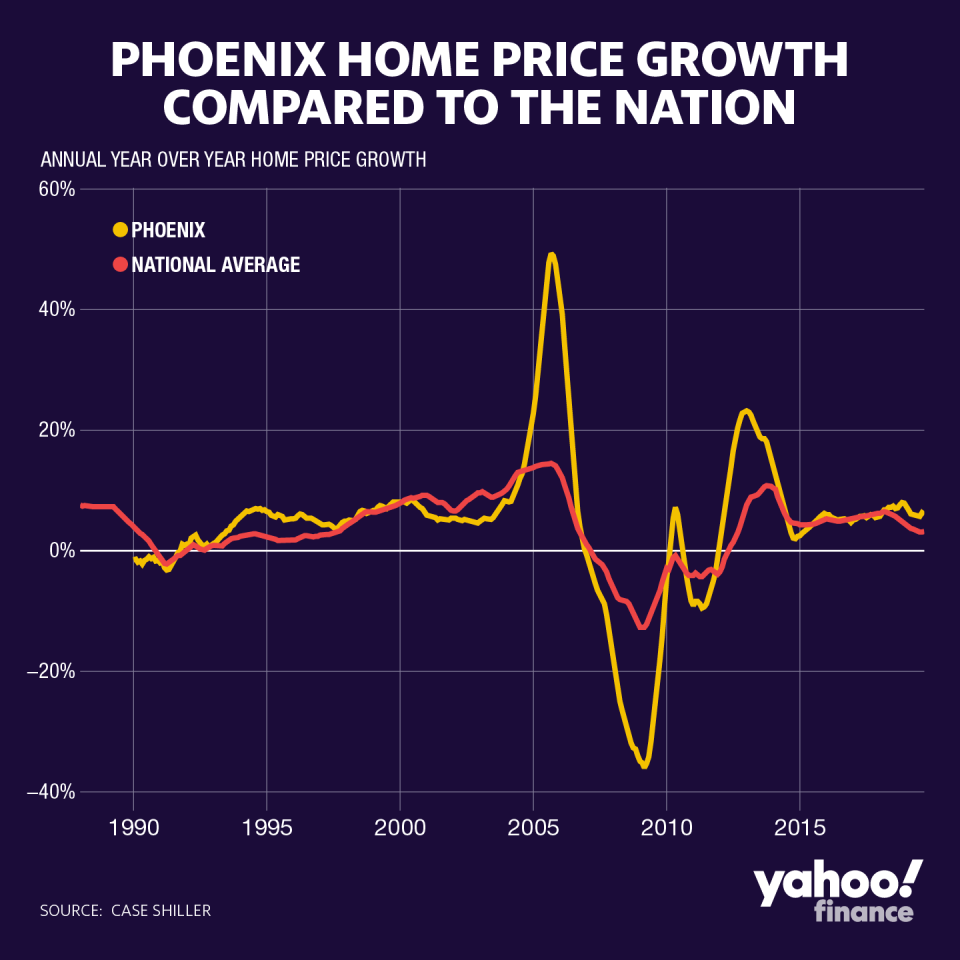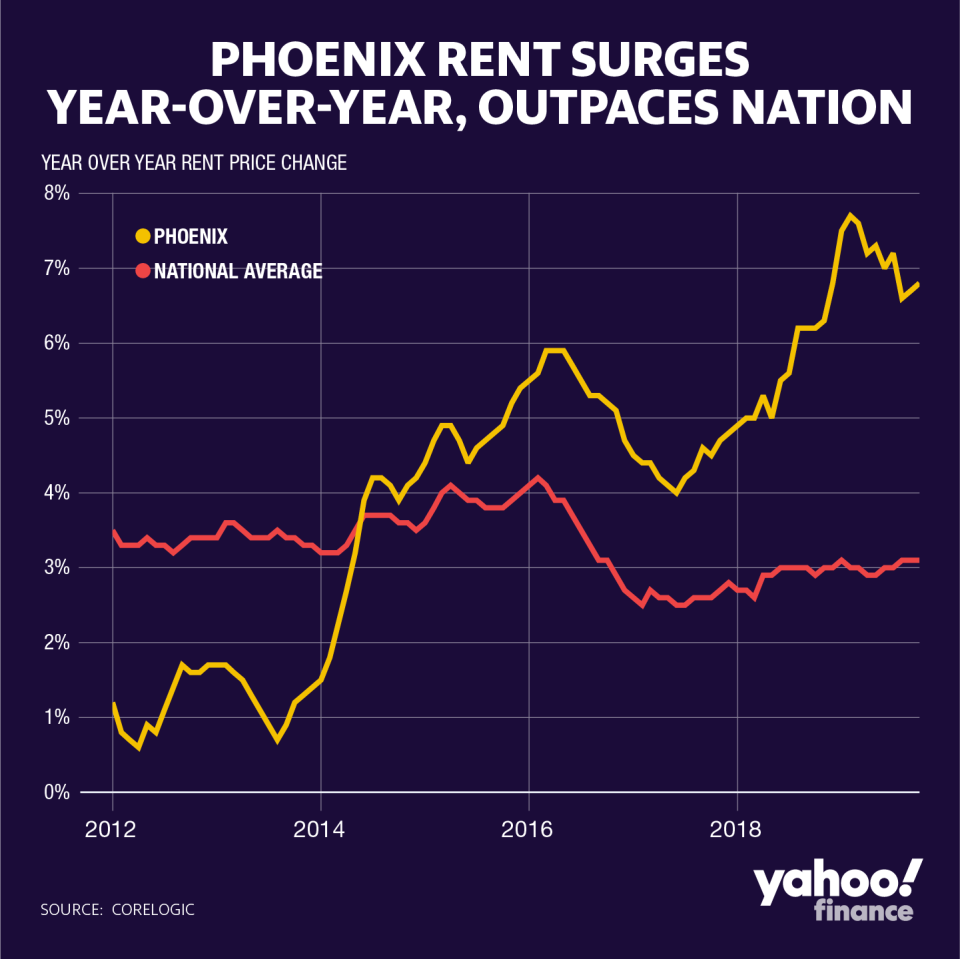The hottest housing market of 2019
Whether you’re looking to buy or rent, Phoenix has always been seen as one of the more desirable and affordable U.S. metro areas.
But this year home prices along with rents have surged in the Valley of the Sun at a rate that has outpaced the nation and other major markets. Phoenix’s strong job market, proximity to more expensive housing markets in California and dry, warm climate have made it the hottest housing market of 2019.
“Phoenix has come back from the ashes, that is to say 10 years ago it was ground zero for the housing market crash,” said Lawrence Yun, chief economist for the National Association of Realtors, adding that since the low point of 2012, “home prices have doubled and are still going strong. It’s quite a fast recovery after a harsh downfall.”
In June, Phoenix dethroned Las Vegas as the city with the fastest home price growth, according to the S&P CoreLogic Case-Shiller 20-City Composite. In September, the city recorded a 6% annual gain in home prices, far outpacing the national home price index, which posted a 3.2% gain and the 20-City, which posted a 2.1% gain, that same month.

And it’s not just home prices. Rent has also been rising faster in the city than elsewhere in the U.S. Phoenix led the The CoreLogic Single-Family Rent Index, which looks at rent price change nationally and among 20 metro areas, for 11 straight months. In October, the city posted the highest year-over-year increase at 6.8% — far outpacing the national annual increase of 3.1%.
“We are experiencing a robust housing market,” said Scott Colbert, Phoenix market manager for real estate brokerage Redfin. “What’s fueling the demand is a great local economy.”
Employment growth in Phoenix is 2.4%, compared with the national employment growth average of 1.4%, according to the U.S. Bureau of Labor Statistics. The unemployment rate for Phoenix, which includes Scottsdale, was 4.1% in October, higher than the national figure of 3.6%. A rate between 4%-4.5% usually means full employment.
“So that provides an attraction or stimulus for workers who are in weaker economies to come and move to Phoenix,” said Dr. Frank Nothaft, chief economist at CoreLogic.
City for all generations
For the first two quarters of this year, Phoenix topped Redfin’s list of top U.S. migration destinations, based on a sample of more than 1 million who searched for homes on Redfin.com. In the third quarter it was ranked No. 3.
“Since we’ve been tracking migration in 2017, Phoenix has been among the top of the list,” said Daryl Fairweather, RedFin’s chief economist, adding that most people come from Los Angeles and other California cities, where housing is more expensive.
The nation’s fastest-growing U.S. county is also situated in Phoenix. For the third consecutive year, Maricopa County, Arizona’s most populated county, was the fastest-growing from July 2017 to July 2018, according to U.S. Census Bureau data released this year. Additionally, the Phoenix-Mesa-Scottsdale area was the second highest among metropolitan areas in growth, with more than 96,000 people moving to the area, up about 7,000 from last year. The Phoenix metropolitan area has a total population of about 4,857,962.
“On top of that, it’s a community where many Baby Boomers are retiring. They look to markets like Phoenix-Scottsdale area,” said Nothaft. So there is “some increased demand coming from potential retirees in concert with millennials and Gen Z moving there because of good employment. The conditions add to demand for shelter to buy or rent.”
Like the rest of the nation, Phoenix is dealing with a lack of homes for sale and for rent, hence driving up prices. It’s still very much a sellers’ market in Phoenix, according to Colbert. Typically there’s about five to six months of inventory on the market. In Phoenix, there was 1.8 months of supply on the market in October, among the four markets with the lowest supply of inventory in the U.S., according to RE/Max. Of the metros analyzed in the CoreLogic Single-Family Rent Index, Phoenix experienced the largest decrease in vacancy rates at 2.6% in the third quarter, which helped drive rent growth.

Still cheaper to buy
Despite the run-up in prices, Phoenix is still more affordable, if you’re looking to rent or buy, than its neighbors.
Median rents in Phoenix are at $881 for a one-bedroom apartment and $1,098 for a two-bedroom in December, according to the latest Apartment List report. In comparison, a two-bedroom apartment in San Francisco is 2.5 times that price — median rent in December cost $3,101.
In Phoenix as of the third quarter of 2019, the median price of a home was $289,200, according to the National Association of Realtors, half of the cost in San Diego, Los Angeles and San Francisco where median price was $645,000, $649,600 and $964,000, respectively. It’s even still cheaper than Yahoo Finance’s hottest housing market of 2018, Las Vegas, a city that has also benefited from an infux of people from southern or coastal California. In Vegas, the median price of a home was $313,000 in the third quarter.
“Phoenix is a large metro market that also comes with normal city amenities, cultural performances, sports,” said Yun. ”People are realizing in Phoenix they can get larger-sized homes for half the price. Many people are taking advantage of that.”
Amanda Fung is an editor at Yahoo Finance.
Read more
US home price growth rises for the second straight month
Why mortgage delinquencies are at a 12-year low
Homebuyers think a recession will hit by 2022: survey
Read the latest financial and business news from Yahoo Finance
Follow Yahoo Finance on Twitter, Facebook, Instagram, Flipboard, SmartNews, LinkedIn, YouTube, and reddit.

